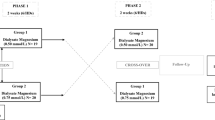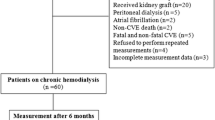Abstract
Background
Iron may contribute to vascular injury through reactive oxygen species. Hemodialysis patients frequently receive iron supply for correction of anemia and are at a high risk of cardiovascular disease. We tested the relationship between iron status and change in arterial stiffness in hemodialysis patients.
Patients and methods
We measured iron status in 53 hemodialysis patients and studied the association with clinical, biochemical, and arterial stiffness measured by brachial–ankle pulse wave velocity (baPWV) over 3 years. The blood pressure was controlled to below 140/90 mmHg by anti-hypertensive drugs.
Results
Median and interquartile range of baseline baPWV, baPWV at 3 years, and ΔbaPWV (difference between 3-year baPWV and baseline baPWV) were following: 17.6 (14.8–18.9), 16.9 (15.3–19.9), and 0.2 (−1.2 to 2.7) m/s. At baseline, baPWV was positively correlated with age, serum ferritin, and systolic blood pressure in univariate analysis. However, in multivariate analysis, only age and serum ferritin remained the significant determinants of baseline baPWV. After 3 years, ΔbaPWV was negatively correlated with age and positively with 3-year averaged serum ferritin in univariate analysis. Then, in multivariate analysis, only 3-year averaged serum ferritin was the important determinant of ΔbaPWV. ΔbaPWV was significantly increased in patients with 3-year averaged serum ferritin >500 ng/mL compared to patients with 3-year averaged serum ferritin ≤500 ng/mL.
Conclusions
In hemodialysis patients, serum ferritin associates with the progressive arterial stiffness, especially when serum ferritin >500 ng/mL.

Similar content being viewed by others
References
Ramakrishna G, Rooke TW, Cooper LT (2003) Iron and peripheral arterial disease: revisiting the iron hypothesis in a different light. Vasc Med 8:203–210
Vinchi F, Muckenthaler MU, Da Silva MC, Balla G, Balla J, Jeney V (2014) Atherogenesis and iron: from epidemiology to cellular level. Front Pharmacol 5:94
Drueke T, Witko-Sarsat V, Massy Z et al (2002) Iron therapy, advanced oxidation protein products, and carotid artery intima-media thickness in end-stage renal disease. Circulation 106:2212–2217
Wolff B, Volzke H, Ludemann J et al (2004) Association between high serum ferritin levels and carotid atherosclerosis in the study of health in pomerania (SHIP). Stroke 35:453–457
Sullivan JL (1981) Iron and the sex difference in heart disease risk. Lancet 1981(1):1293–1294
Menke A, Fernandez-Real JM, Muntner P, Guallar E (2009) The association of biomarkers of iron status with peripheral arterial disease in us adults. BMC Cardiovasc Disord 9:34
Morrison HI, Semenciw RM, Mao Y, Wigle DT (1994) Serum iron and risk of fatal acute myocardial infarction. Epidemiology 5:243–246
Ramakrishnan U, Kuklina E, Stein AD (2002) Iron stores and cardiovascular disease risk factors in women of reproductive age in the united states. Am J Clin Nutr 76:1256–1260
Baer DM, Tekawa IS, Hurley LB (1994) Iron stores are not associated with acute myocardial infarction. Circulation 89:2915–2918
Solymoss BC, Marcil M, Gilfix BM, Gelinas F, Poitras AM, Campeau L (1994) The place of ferritin among risk factors associated with coronary artery disease. Coron Artery Dis 5:231–235
Blacher J, Guerin AP, Pannier B, Marchais SJ, Safar ME, London GM (1999) Impact of aortic stiffness on survival in end-stage renal disease. Circulation 99:2434–2439
Kimoto E, Shoji T, Shinohara K (2003) Preferential stiffening of central over peripheral arteries in type 2 diabetes. Diabetes 52:448–452
O’Rourke M (1995) Mechanical principles in arterial disease. Hypertension 26:2–9
Yamashina A, Tomiyama H, Arai T et al (2003) Brachial-ankle pulse wave velocity as a marker of atherosclerotic vascular damage and cardiovascular risk. Hypertens Res 26:615–622
Chuang SY, Chen CH, Cheng CM, Chou P (2005) Combined use of brachial-ankle pulse wave velocity and ankle-brachial index for fast assessment of arteriosclerosis and atherosclerosis in a community. Int J Cardiol 98:99–105
Kim DH, Kim J, Kim JM, Lee AY (2008) Increased brachial-ankle pulse wave velocity is independently associated with risk of cerebral ischemic small vessel disease in elderly hypertensive patients. Clin Neurol Neurosurg 110:599–604
Kitahara T, Ono K, Tsuchida A (2005) Impact of brachial-ankle pulse wave velocity and ankle-brachial blood pressure index on mortality in hemodialysis patients. Am J Kidney Dis 46:688–696
Kalantar-Zadeh K, Lee GH (2006) The fascinating but deceptive ferritin: to measure it or not to measure it in chronic kidney disease? Clin J Am Soc Nephrol 1(Suppl 1):S9–18
Senol E, Ersoy A, Erdinc S, Sarandol E, Yurtkuran M (2008) Oxidative stress and ferritin levels in haemodialysis patients. Nephrol Dial Transplant 23:665–672
KDOQI (2006) clinical practice guidelines and clinical practice recommendations for anemia in chronic kidney disease. Am J Kidney Dis 47:S11–145
Byon CH, Javed A, Dai Q et al (2008) Oxidative stress induces vascular calcification through modulation of the osteogenic transcription factor runx2 by akt signaling. J Biol Chem 283:15319–15327
Nakahara T, Sato H, Shimizu T (2010) Fibroblast growth factor-2 induces osteogenic differentiation through a runx2 activation in vascular smooth muscle cells. Biochem Biophys Res Commun 394:243–248
Neven E, De Schutter TM, Behets GJ, Gupta A, D’Haese PC (2011) Iron and vascular calcification. Is there a link? Nephrol Dial Transplant 26:1137–1145
Rocha LA, Barreto DV, Barreto FC (2009) Serum ferritin level remains a reliable marker of bone marrow iron stores evaluated by histomorphometry in hemodialysis patients. Clin J Am Soc Nephrol 24:105–109
Lim PS, Wei YH, Yu YL, Kho B (1999) Enhanced oxidative stress in haemodialysis patients receiving intravenous iron therapy. Nephrol Dial Transplant 14:2680–2687
Kuo KL, Hung SC, Wei YH, Tarng DC (2008) Intravenous iron exacerbates oxidative DNA damage in peripheral blood lymphocytes in chronic hemodialysis patients. J Am Soc Nephrol 219:1817–1826
Martin-Malo A, Merino A, Carracedo J (2012) Effects of intravenous iron on mononuclear cells during the haemodialysis session. Nephrol Dial Transplant 27:2465–2471
de Vecchi AF, Novembrino C, Lonati S, Ippolito S, Bamonti F (2007) Two different modalities of iron gluconate i.v. administration: effects on iron, oxidative and inflammatory status in peritoneal dialysis patients. Nephrol Dial Transplant 22:1709–1713
Tomiyama H, Yamashina A, Arai T et al (2003) Influences of age and gender on results of noninvasive brachial-ankle pulse wave velocity measurement—a survey of 12517 subjects. Atherosclerosis 166:303–309
Nomura K, Nakao M, Karita K, Nishikitani M, Yano E (2005) Association between work-related psychological stress and arterial stiffness measured by brachial-ankle pulse-wave velocity in young Japanese males from an information service company. Scand J Work Environ Health 31:352–359
Choi KM, Lee KW, Seo JA et al (2004) Relationship between brachial-ankle pulse wave velocity and cardiovascular risk factors of the metabolic syndrome. Diabetes Res Clin Pract 66:57–61
Fujiwara Y, Chaves P, Takahashi R et al (2004) Relationships between brachial-ankle pulse wave velocity and conventional atherosclerotic risk factors in community-dwelling people. Prev Med 39:1135–1142
Rambod M, Kovesdy CP, Kalantar-Zadeh K (2008) Combined high serum ferritin and low iron saturation in hemodialysis patients: the role of inflammation. Clin J Am Soc Nephrol 3:1691–1701
Kalantar-Zadeh K, Rodriguez RA, Humphreys MH (2004) Association between serum ferritin and measures of inflammation, nutrition and iron in haemodialysis patients. Nephrol Dial Transplant 19:141–149
Author information
Authors and Affiliations
Corresponding author
Ethics declarations
Conflict of interest
All authors declare no conflict of interest.
Additional information
Kao-Chang Lin and Meng-Yi Tsai have contributed equally to this work.
Rights and permissions
About this article
Cite this article
Lin, KC., Tsai, MY., Chi, CL. et al. Serum ferritin is associated with arterial stiffness in hemodialysis patients: results of a 3-year follow-up study. Int Urol Nephrol 47, 1847–1853 (2015). https://doi.org/10.1007/s11255-015-1090-1
Received:
Accepted:
Published:
Issue Date:
DOI: https://doi.org/10.1007/s11255-015-1090-1




